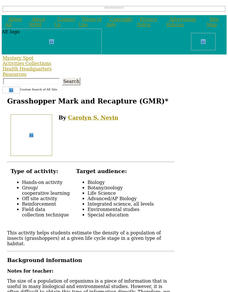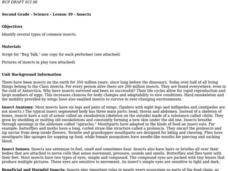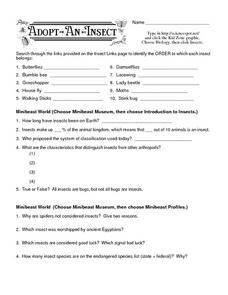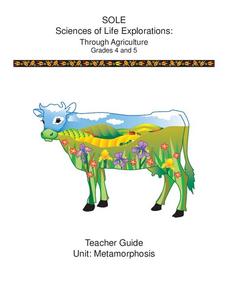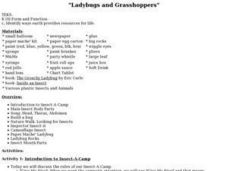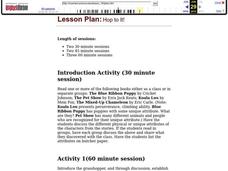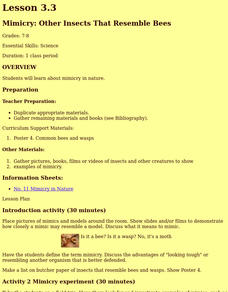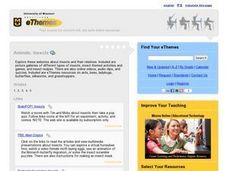Cornell University
Insect IPM
Find out the characteristics that makes a bug an insect with a workbook designed to inform scholars about the crawly creatures that live around us. Scholars complete an ant-themed word search, answer questions using a solution key,...
Curated OER
Grasshopper Mark and Recapture (GMR)
Students estimate the density of a population of insects (grasshoppers) at a given life cycle stage in a given type of habitat.
Curated OER
What Is An Insect?
Students find and classify insects. They collect insects, study them with a hand lens and identify its body parts. Afterwards, they discus various types of insects and thier Orders such as beetles, butterflies and moths, grasshoppers, etc.
Curated OER
Insect Anatomy
Break down insect anatomy with this learning exercise! Class members diagram insect anatomy by drawing a line from the names of grasshopper body parts to the corresponding parts on an image of a grasshopper. The learning exercise...
EnLiST
Trap Your Own Insects: What’s in Your Backyard?
Young entomologists construct three types of insect traps—pitfall, pollinator, and panel—before setting their traps out and observing what they caught. They then observe what types of insects the different traps attract.
Curated OER
Insects: Grasshoppers
Students examine grasshoppers as they practice following instructions. In this biology lesson plan, students identify the characteristics of grasshoppers and the functions of grasshoppers' external body parts.
Curated OER
Insects
Second graders brainstorm and identify several types of common insects. They play bug bingo, building bugs and an insect tree, observing real insects in the classroom and examining some of the things insects make.
Curated OER
Adopt-An-Insect III
In this biology worksheet, students search through the links provided on insects to identify the order to which each insect belongs. Then they write the characteristics that distinguish insects from other arthropods. Students also select...
Curated OER
Create An Insect
Young scholars create a new species of insect. They create a list of insect characteristics and use this as a springboard to draw an insect of their own. Students write a brief descriptive paragraphs about their insect, giving...
Curated OER
Hopper Circus
Students explore biology by participating in an insect identification activity. In this grasshopper lesson plan, students discuss the types of insects who jump high and identify their anatomical parts. Students collect a group of...
Cornell University
Metamorphosis
Looking for an insect unit that addresses multiple skill strategies? Young entomologists explore multiple life cycles of insects that go through metamorphosis. The brainteasers and mobile activity spark learner interest before guiding...
Curated OER
Parts of an Insect
In this science worksheet students will label the parts of an insect. Students will synthesize a list of insect names for each letter of the alphabet.
Curated OER
"Ladybugs and Grasshoppers"
Learners paricipate in number of activities related to ladybugs and grasshoppers.
Curated OER
Bug's Eye View
Investigate the life of bugs and how they interact with the environment in this integrated science and language arts lesson. Young scientists construct mini environments in cages in order to make observations. This data forms the basis...
Curated OER
Hop To It!
Learners explore grasshoppers. In this grasshoppers lesson, students measure the jumping distance of live grasshoppers. Learners then record the jumping distance of people in their group. Students record the distances and...
Curated OER
What is an Insect?
Learners examine insects and identify physical characteristics of insects. They perform observations of insects, then use a worksheet imbedded in this plan to answer questions about them.
Curated OER
Insects
Students read books, learn about the letter i, and eat raisins that represent ants all to learn about insects. In this insects lesson plan, students also observe an ant farm and play follow the leader.
Curated OER
Mimicry: Other Insects That Resemble Bees
Young scholars design a conceptual experiment to test whether mimics actually benefit from the fact they resemble other organisms or objects. They define the term mimicry. They focus on insects that resemble bees and wasps.
Curated OER
Positive/Negative Bugs
Bugs can be creepy - and fun! Kids create a positive and negative design by repeatedly drawing a simple insect overlaid with a geometric shape. The outcome is really neat and will help build spacial reasoning, visual acuteness,...
Curated OER
Adopt-An-Insect: Scavenger Hunts 1, 2, and
In this insect scavenger hunt activity, students use the charts to keep track of the 52 insects they attempt to find as they complete 3 scavenger hunts.
Curated OER
Insect Classification
Sixth graders learn the classification system of living organisms. They identify general body parts of an insect, learn insect classification into orders, families, genus and species, and classify given insects by using a scientific...
Curated OER
Interesting Insects
Students discover the characteristics of insects. They explore insects through cooperative learning, group projects, hands on activities, and poetry. They gain knowledge of insect life cycles, habitat, and physical characteristics.
Curated OER
Introduction To Insect & Spider Body Parts
Students inspect several different specimens of insects and spiders to determine characteristics that are similar and different between the two groups. They identify the basic body structure of spiders and insects and then predict where...
Curated OER
Animals: Insects
Learners use the Internet to examine insects and their relatives. They participate in online games and discover insect recipes.

